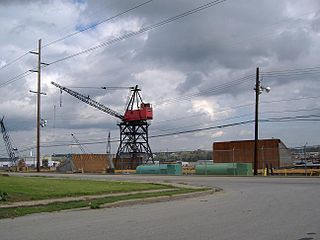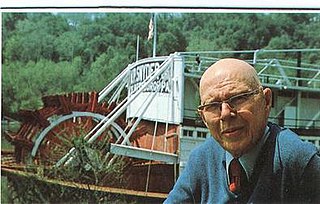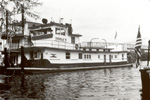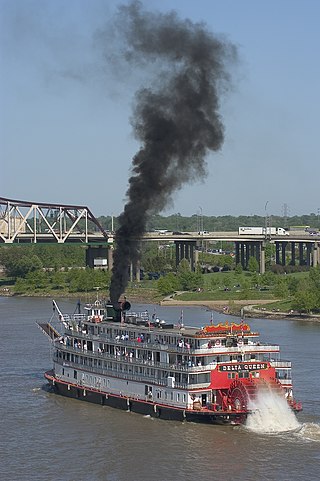
A steamboat is a boat that is propelled primarily by steam power, typically driving propellers or paddlewheels. Steamboats sometimes use the prefix designation SS, S.S. or S/S or PS ; however, these designations are most often used for steamships.

A pusher, pusher craft, pusher boat, pusher tug, or towboat, is a boat designed for pushing barges or car floats. In the United States, the industries that use these vessels refer to them as towboats. These vessels are characterized by a square bow, a shallow draft, and typically have knees, which are large plates mounted to the bow for pushing barges of various heights. These boats usually operate on rivers and inland waterways. Multiple barges lashed together, or a boat and any barges lashed to it, are referred to as a "tow" and can have dozens of barges. Many of these vessels, especially the long distance, or long haul boats, include living quarters for the crew.

Anson Northup was a 100-horsepower (75 kW) sternwheel riverboat named for her captain who was the first to navigate the Red River of the North from Fort Abercrombie, Dakota Territory, to Fort Garry, Rupert's Land, departing 6 June and arriving 10 June 1859. Sold and renamed Pioneer, she sank during the winter of 1861–62. Pioneer was dismantled and her boiler reused by SS Colvile.

The Delta Queen is an American sternwheel steamboat. She is known for cruising the major rivers that constitute the tributaries of the Mississippi River, particularly in the American South, although she began service in California on the Sacramento River delta for which she gets her name. She was docked in Chattanooga, Tennessee and served as a floating hotel until purchased by the newly formed Delta Queen Steamboat Company. She was towed to Houma, Louisiana, in March 2015 for refurbishing to her original condition.

Jeffboat was a shipyard in Jeffersonville, Indiana founded by James Howard in 1834, a builder of steamboats. The company was owned by the Howard family until it was sold leading up to World War II. Following the war, it became known as the Jeffersonville Boat and Machine Company and later changed its name to Jeffboat, the more commonly used short form of its name. The company was the largest inland shipbuilder in the United States and the second-largest builder of barges before it closed in 2018.

Fredrick Way Jr. was the youngest steamboat captain on the Ohio River and Mississippi River. He was the author of books on the boats that ply the inland waterways. He supervised the flat-bottom, stern paddlewheeler, the Delta Queen, from San Francisco, down the Pacific coast, through the Panama Canal, across the Gulf of Mexico and up the Mississippi and Ohio rivers to Pittsburgh in 1946.

Lone Star is a wooden hull, steam-powered stern-wheeled towboat in LeClaire, Iowa, United States. She is dry docked and on display at the Buffalo Bill Museum in LeClaire. Built in 1868, she is the oldest of three surviving steam-powered towboats, and the only one with a wooden hull. She was declared a National Historic Landmark on 20 December 1989.

President is a steamboat that currently lies dismantled in Effingham, Illinois, United States. Originally named Cincinnati, it was built in 1924 and is the only remaining "Western Rivers" style sidewheel river excursion steamboat in the United States. She was listed on the National Register of Historic Places and declared a National Historic Landmark in 1989, although these designations were revoked in 2011. Her home ports have been Cincinnati, Ohio; New Orleans, Louisiana; Vicksburg, Mississippi; St. Louis, Missouri; and Davenport, Iowa.

Many steamboats operated on the Columbia River and its tributaries, in the Pacific Northwest region of North America, from about 1850 to 1981. Major tributaries of the Columbia that formed steamboat routes included the Willamette and Snake rivers. Navigation was impractical between the Snake River and the Canada–US border, due to several rapids, but steamboats also operated along the Wenatchee Reach of the Columbia, in northern Washington, and on the Arrow Lakes of southern British Columbia.

Standard, also known historically as Donald B and Barbara H, is a paddlewheel towboat that has been named a US National Historic Landmark and is now based at Bellaire in eastern Ohio. Built in 1923, she is the oldest surviving unaltered rear-wheel towboat afloat. The boat was declared a National Historic Landmark in 1989.

Captain Gordon Christopher Greene, was the owner of the Greene Line of river steamboats.
Gordon C. Greene was a paddle steamer, launched in 1923, that operated under several names before sinking in St. Louis in 1967.
Captain Christopher Becker Greene was the head of the Greene Line of steamboats after the death of his father.

Captain Thomas Rea Greene was president of the Greene Line of steamboats.

The Greene Line was a line of river steamships along the Ohio River. The name was changed in 1973 to Delta Queen Steamboat Company.

The Island Queen was a series of two American sidewheeler steamboats built in 1896 and 1925 respectively. Both vessels were passenger carriers cruising along the Mississippi and Ohio rivers as both an excursion boat and tramp steamer. The first Island Queen burned in 1922 in a fire which destroyed several other vessels. The second Island Queen was destroyed in 1947 when her chief engineer, using a welding torch, accidentally cut into her fuel tank. Island Queen was reduced to her steel frame, and was scrapped by a local company.
Streckfus Steamers was a company started in 1910 by John Streckfus Sr. (1856–1925) born in Edgington, Illinois. He started a steam packet business in the 1880s, but transitioned his fleet to the river excursion business around the turn of the century. In 1907, he incorporated Streckfus Steamers to raise capital and expand his riverboat excursion business. A few years later, the firm acquired the Diamond Jo Line, a steamboat packet company.

I. C. Woodward was a side-wheel packet boat launched in July 1898 by Andrew Axton & Son Co. of West Brownsville, Pennsylvania, for the Pittsburgh, Brownsville and Geneva Packet Company. She was named for ship captain Isaac C. Woodward. I. C. Woodward was 164 ft (50 m) long by 42 ft (13 m) wide with a 5 ft (1.5 m) draft. She had 50 staterooms with additional passenger room in her texas.

The Twilight was an American sternwheeler towboat that was built in 1864 in Middletown, Pennsylvania. Initially named as the Traveler, she was rebuilt in 1882 by Lew Clark and renamed as the Twilight. She was then renamed again in May 1927 as the J. H. McCrady.

Santa Claus was a sidewheel passenger-and-freight steamboat built in 1845 for service on the Hudson River between Wilbur, New York, and New York City. In her first few years of operation, Santa Claus saw service on a number of different Hudson River routes, most notably between Albany and New York City. She was also employed from time to time as an excursion steamer. A highlight of her career occurred in 1852, when she had the honor of conveying the remains of American statesman Henry Clay from New York City to Albany en route to their final resting place.

















